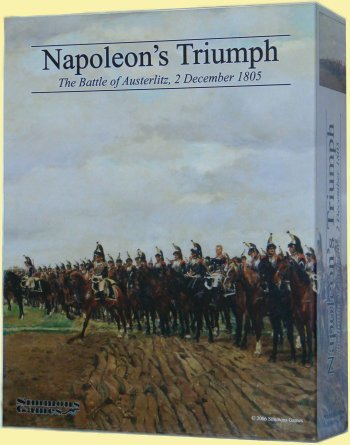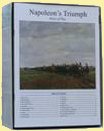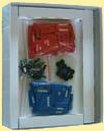The battle of Austerlitz.
On 2 December 1805, the Emperor Napoleon had lured the Allied Army under Czar Alexander into attacking him in one of the most famous traps in military history. The Allied army attacked but was split in two by a French counter-attack and disastrously defeated, giving Napoleon one of the greatest victories in the history of war – Austerlitz.
Napoleon's Triumph is a game without any luck. It is built on the same foundations as its acclaimed predecessor, Bonaparte at Marengo, but introduces some new mechanics and is bigger and grander in scale. It uses two boards to make a double-size 44" x 34" map of the Austerlitz battlefield. It comes with 140 wooden units and 18 metal corps commanders. It is played without dice. If players have internalised the rules, it can be played from start to finish in about 2 to 3 hours.
|
|

|
|
| |
The cover art is Jean-Louis-Ernest Meissonier's oil painting "The Cuirassiers of 1805". This particular painting is of th 12th French cuirassier regiment awaiting orders on the battlefield of Austerlitz.
On opening the box, the rules for Napoleon's Triumph are revealed. The rule booklet is 12 pages long, bound with staples, and printed in full color. Because Napoleon's Triumph is a two player game, and it is not uncommon for both players to be learning the game at the same time, two copies of the rules booklet are provided, one for each player.
Underneath the rules are the hardmounted game boards and the wooden and metal game pieces.
|
The game pieces consist of 140 wooden blocks representing the two armies, 18 metal command pieces representing the commanders and their staffs, and a dozen wooden markers for record-keeping. The wooden blocks are silk-screened on one side to indicate their type (guard, infantry, cavalry, artilleriy) and strength (1 to 3).
The huge 44 x 34" game board is hard-mounted and uses European-folds so that there are no valleys breaking up the smooth playing surface. Of particular interest is the map design. Forgoing the conventional hexagonal grid, the map uses a design unique to Simmons Games featuring polygons to regulate movement and combat.
The Pieces can be grouped as a corps or can be used individually (see picture to the right).
A player can only see the type and strength of his own pieces, which are faced to himself, while leaving the blank sides facing his opponent (who can only guess about the forces which are rolling in his direction).
|
|

|





